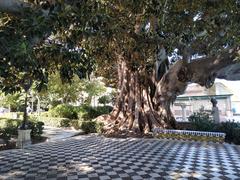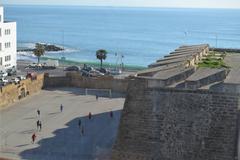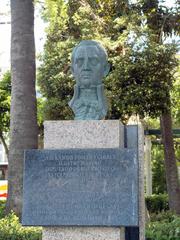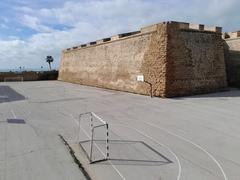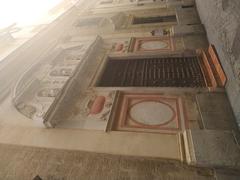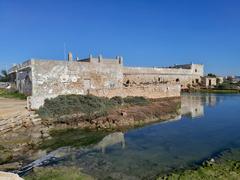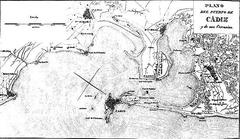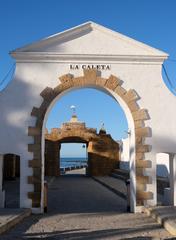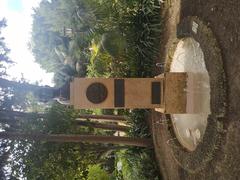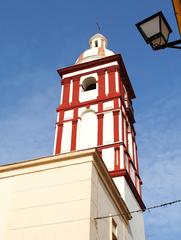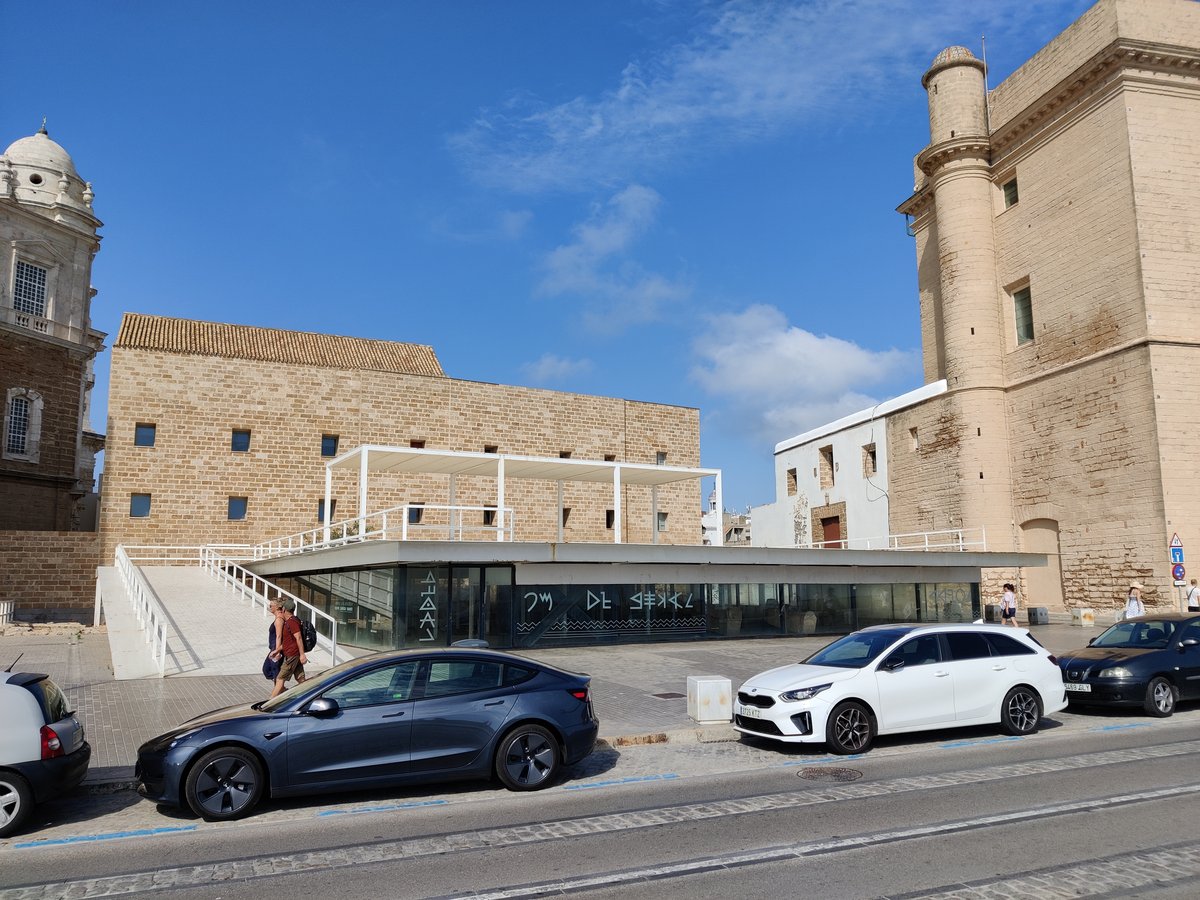
Casa del Obispo, Cádiz, Spain — Visiting Hours, Tickets, and Historical Sites Guide
Date: 14/06/2025
Introduction: Casa del Obispo — Cádiz’s Timeless Archaeological Landmark
In the heart of Cádiz’s historic center, Casa del Obispo stands as one of Spain’s most remarkable archaeological sites, encapsulating more than 3,000 years of history. From its origins as a Phoenician outpost to its later roles under Carthaginian, Roman, Islamic, and Christian influences, Casa del Obispo offers an unparalleled window into the city’s evolution as one of Western Europe’s oldest continuously inhabited settlements. Despite its current closure due to ongoing conservation and administrative challenges, the site remains a focal point of heritage preservation and scholarly study.
This guide provides a comprehensive overview of Casa del Obispo’s historical significance, key archaeological discoveries, current visitor information, and practical travel tips. For official updates on visiting hours, ticket availability, and reopening plans, consult Guía de Cádiz, Visiting Cádiz, and the Official Cádiz Tourism site.
1. Historical Overview
Phoenician Foundations
Casa del Obispo is built atop the earliest remains of Gadir, the Phoenician name for Cádiz, dating back to the 8th century BCE. Excavations have revealed a monumental funerary complex from this period, considered one of the most significant Phoenician burial sites in the Iberian Peninsula (Guía de Cádiz; Visiting Cádiz). These finds underscore the city’s early importance as a religious and commercial hub in the western Mediterranean.
Carthaginian and Roman Transformations
During the Carthaginian (Punic) era, the site was further monumentalized, serving as a sacred precinct. With the Roman conquest, Casa del Obispo underwent another transformation. Roman buildings were constructed atop earlier structures, and the site became associated with rituals dedicated to healing deities such as Apollo, Aesculapius, and Hygieia (Visiting Cádiz). This period reflects the Roman tradition of blending local and imported religious practices, further cementing the site’s status as a center of worship.
Islamic and Medieval Layers
Following the decline of Roman authority, the site saw continued use during the Islamic period, possibly as a residence for the mosque’s muezzin. Archaeological finds—such as food storage amphorae—point to ongoing daily life (Tegusta Viajar). In the 16th century, the site became the residence of Bishop Luis García de Haro, giving rise to the name “Casa del Obispo” (Bishop’s House) (Guía de Cádiz). The episcopal palace incorporated earlier structures, reflecting centuries of adaptation.
2. Archaeological Discoveries and Site Significance
Casa del Obispo offers a unique crono-stratigraphic sequence, preserving evidence of continuous occupation from the 8th century BCE to the present. Excavations have revealed:
- A monumental Phoenician-Punic tomb with a stone chamber and luxury grave goods, including a gold ring and purple-dyed textiles (Academia.edu).
- Ritual wells and pits containing ceramics, animal bones, and organic residues—traces of funerary banquets and secondary rites.
- Imported pottery and luxury goods, testifying to Cádiz’s role as a Mediterranean trading port.
- Superimposed urban layers, including Roman, Islamic, and early modern structures, accessible via glass walkways and interpretive displays.
The site’s educational value is enhanced by modern installations and explanatory panels, making its complex history accessible to all audiences (Guía de Cádiz).
3. Current Status, Visiting Hours, and Ticket Information
Temporary Closure and Conservation Challenges
As of June 2025, Casa del Obispo remains closed due to administrative and legal disputes, as well as storm-related structural damage (Diario de Cádiz). The closure is linked to unresolved contractual issues between the Cádiz City Council, the site’s concessionaire, and the property owner (the Bishopric of Cádiz). Structural repairs and funding shortfalls continue to delay reopening.
Visiting Hours and Tickets
- Status: Closed to the public; no confirmed reopening date.
- Usual Schedule (pre-closure): Tuesday to Sunday, 10:00–17:00/18:00; closed Mondays and major holidays.
- Admission Fees (pre-closure): €5–€7 for adults; discounts for students, seniors, children; children under 6–8 free.
- Ticketing: When reopened, advance booking is recommended, especially during peak seasons and festivals.
- Accessibility: Located in the city center, within walking distance of major landmarks; ramps and elevators are planned for future accessibility improvements.
Stay updated via the Official Cádiz Tourism site and Guía de Cádiz.
4. Visitor Experience: What to Expect
Site Layout
Casa del Obispo features a modern entrance leading to subterranean remains. Glass walkways and thoughtful lighting allow exploration of ancient structures without disturbing them. Bilingual interpretive panels (Spanish/English) and digital resources enrich the experience.
Key Highlights
- Remnants from Phoenician, Roman, and medieval periods.
- Monumental tombs, city walls, and domestic structures.
- Guided tours (when available) in Spanish and sometimes English.
- Air-conditioned exhibition areas for visitor comfort.
Accessibility
The main exhibition areas are wheelchair accessible, though some uneven surfaces may present minor challenges. Contact the site in advance for specific needs.
Facilities
- Modern restrooms
- Cloakroom
- Gift shop with books and souvenirs
- Non-flash photography permitted; professional gear requires permission
- Free Wi-Fi (in visitor center, when open)
5. Location, Travel Tips, and Nearby Attractions
- Address: Calle Obispo José María Rancés, 12, 11005 Cádiz, Spain
- Getting There: 10-minute walk from Cádiz main train station; well-served by local buses and taxis; parking outside the old town is recommended (Always in Spain).
- Nearby Sites: Cádiz Cathedral, Roman Theatre, Barrio del Pópulo, lively plazas, and tapas bars (The Crazy Tourist).
- Dining: No on-site café, but many local options steps away.
- Best Times: Early morning or late afternoon for fewer crowds; spring/autumn for pleasant weather; local festivals for a vibrant atmosphere.
6. Frequently Asked Questions (FAQ)
Q: Is Casa del Obispo currently open to visitors?
A: No, the site is closed due to conservation and legal issues. No reopening date has been announced.
Q: How can I get tickets?
A: Tickets will be available online and on-site when the site reopens. Monitor official tourism sites for announcements.
Q: Is the site wheelchair accessible?
A: The main exhibition areas are designed for accessibility, though some uneven surfaces remain.
Q: Are guided tours available?
A: Guided tours are typically offered in Spanish and sometimes English; booking ahead is recommended.
Q: Can I take photographs?
A: Non-flash photography is generally allowed; professional equipment requires permission.
Q: What else can I visit nearby?
A: Cádiz Cathedral, Roman Theatre, and the Old Town are all within walking distance.
7. Planning and Enhancing Your Visit
- Check official sources for up-to-date reopening news.
- Download the Audiala app for interactive guides and real-time updates.
- Combine Casa del Obispo with other Cádiz sites for a comprehensive experience.
- Follow Cádiz tourism on social media for travel tips and event announcements.
8. Conservation Outlook
The future of Casa del Obispo depends on resolving legal and financial challenges to enable restoration and safe public access. Reopening this singular site would significantly enrich Cádiz’s cultural offerings and provide visitors with an extraordinary opportunity to experience the city’s multi-layered past (Lista Roja Hispania Nostra).
9. References and Official Links
- Guía de Cádiz
- Academia.edu
- Diario de Cádiz
- Casa del Obispo (Ayuntamiento de Cádiz)
- Visiting Cádiz
- Lista Roja Hispania Nostra
- Tegusta Viajar
- Official Cádiz Tourism website
- Always in Spain
- The Crazy Tourist
10. Summary & Call to Action
Casa del Obispo is a must-see for anyone interested in the deep history of Cádiz. Its stratified remains—spanning Phoenician, Roman, and later periods—offer invaluable insights into the city’s past. Although currently closed, prospective visitors should stay informed through official tourism channels and cultural resources. When Casa del Obispo reopens, it will once again provide an immersive journey beneath Cádiz’s vibrant streets. Until then, explore nearby sites and digital content to enrich your understanding of this Mediterranean crossroads.
Ready to discover Cádiz’s ancient secrets?
Download the Audiala app for guide content and real-time updates, follow Cádiz tourism channels, and continue exploring the city’s rich history.

